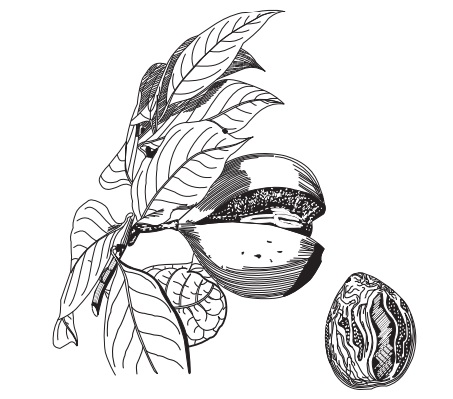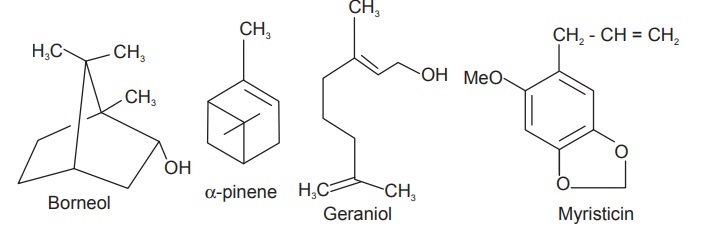Nutmeg
| Home | | Pharmacognosy |Chapter: Pharmacognosy and Phytochemistry : Drugs Containing Volatile Oils
Nutmeg is the kernel of the dried ripe seed of Myristica fragrans Houtten., belonging to family Myristicaceae.
NUTMEG
Synonyms
Semen myristicae, Myristica, Nux moschata, Myristica aromata.
Biological Source
Nutmeg is the kernel of the dried ripe seed of Myristica fragrans Houtten., belonging to family Myristicaceae.
Geographical Source
A native of Molucca islands in Indonesia. It is also
cultivated in West Indies, Banda Islands, Archipelago, Malayan, Sumatra, and
in Guiana.
Cultivation, Collection, and Preparation
Nutmeg grows well in well-drained loamy soil, in hot and
humid climate but requires protection from wind. It is cultivated using seeds
and they are protected from wind using banana plantation in between. Nutmeg is
a dioecious tree bearing male and female flowers separately. As the drug is
obtained only from female plant, the male trees are removed with a proportion
of 1:7 (one male for seven female plants). The tree is about 25 feet high, has
a greyish-brown smooth bark, abounding in a yellow juice. The branches spread
in whorls. Male flowers have three to five more on a peduncle, female are
similar to that of the male but their pedicel is solitary. The tree does not
flower till it is nine years old, but once it starts to flower it continues to
do so for 75 years without any attention. The fruits are harvested twice or
thrice a year, that is, in July or August the next in November and finally in
March or April. The fruit is collected in the morning by means of a barb attached
to a long stick. Fruit is a pendulous, globose drupe, consisting of a pericarp
with light yellow colour with the mace arillus covering the hard endocarp. The
arillus are stripped off and forms a mace. The arillus when fresh is a
brilliant scarlet and when dry becomes more horny, brittle, and yellowish-brown
in colour. Seeds are dried in trays kept at a height of about 3 m on charcoal
fire during night, and during day they are kept under sun to have a continuous drying
process. The testa is removed by crack-ing the seeds using a wooden mallet and
the kernels are removed. The drug is graded and packed.
Characteristics
Nutmeg is the kernels consisting of outer and inner
perisperm, endosperm and embryo; it has an ovoid or broadly elongated shape
with a size of 2 to 3 cm length and 1.5 to 2 cm wide. The kernels are greyish
brown in colour, with numerous reddish brown spots on them. One end of the
nutmeg has a small depression indicating the position of micropyle and slightly
by its side it has the position of hilum. The line of raphe extends to opposite
end of the kernel to the depression called chalaza. The embryo is present in a
small cavity inside the endosperm.

Chemical Constituents
Nutmeg contains of 5 to 15% volatile oil, lignin, stearin,
starch, gum, colouring matter, and 0.08% of an acid substance. The volatile oil
contains clemicine, myristicin, geraniol, borneol, pinene, camphene, and
dipentene. It also contains eugenol, safrol, p-cymene and isoeugenol in small
quantity.

Uses
Nutmeg is aromatic, carminative, flavouring agent. Both
nutmeg and mace are used for flatulence, in allay nausea and vomiting. Graded
nutmeg along with lard is used in ointment for piles. It has narcotic action
and peripherally it irritates and produces anesthetics action, since it
irritates intestine and uterus it can cause abortion. Oil of Nutmeg is used to
conceal the taste of various drugs and as a local stimulant to the
gastrointestinal tract.
Marketed Products
It is one of the ingredients of the preparations known as
Diakof, Geriforte, Mentat, Lukol (Himalaya Drug Company), and Kumaryasava
(Dabur).
